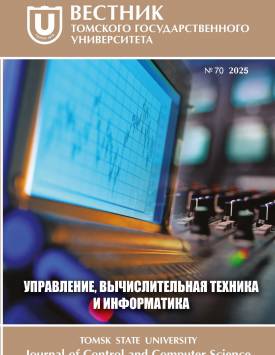Investigation of accuracy of determination of satellite clock bias based on nonlinear regression models
The problem of determining the discrepancy of the onboard clock installed on GLONASS satellites relative to the system time scale based on regression models is being considered. It has been shown that the divergence behavior of time scales is best described by an additive nonlinear regression model in combination with an autoregressive model, with the mean square error for most satellites not exceeding 0.2 ns. Contribution of the authors: the authors contributed equally to this article. The authors declare no conflicts of interests.
Keywords
satellite clock bias,
onboard time scale,
synchronization,
frequency-time corrections,
regression modelAuthors
| Chernikova Oksana S. | Novosibirsk State Technical University | chernikova@corp.nstu.ru |
| Marareskul Tatiana A. | JSC Academician M.F. Reshetnev «Information Satellite System» | mta@iss-reshetnev.ru |
Всего: 2
References
Фатеев В.Ф. К вопросу о релятивистских эффектах смещения шкал времени и частоты наземных и спутниковых квантовых часов в глобальных навигационных спутниковых системах // Альманах современной метрологии. 2023. № 2 (34). С. 43-64.
Сальцберг А.В., Тимошенкова Е.В., Шупен К.Г. Влияние космической среды на ход бортовых часов // Труды Института прикладной астрономии РАН. 2020. Вып. 52. С. 51-56.
Bidikar B., Rao G.S., Laveti G., Kumar M.S. Satellite Clock Error and Orbital Solution Error Estimation for Precise Navigation Applications // Positioning. 2014. Is. 05 (01). P. 22-26.
Liu X., Wu X., Tian Y. Study on atomic prediction of time based on interpolation model with tchebytchev polynomials // Journal of Geodesy and Geodynamics. 2010. Is. 30 (1). P. 77-82.
Wang Y., Lu Z., Sun D., Wang N. A new navigation satellite clock bias prediction method based on modified clock-bias quadratic polynomial model // Acta Astronomica Sinica. 2016. Is. 57 (1). P. 78-90.
Черникова О.С., Марарескул Т.А. Прогнозирование расхождения шкал времени на основе скорректированной линейной модели // Системы анализа и обработки данных. 2022. Т. 87, № 3. С. 37-58.
Xu X., Hu X., Zhou Y., Song Y. Research on high accuracy prediction model of satellite clock bias // China Satellite Navigation Conference (CSNC): Lecture Notes in Electrical Engineering. 2014. Is. 3 (1). P. 155-164.
Liu Q., Sun J., Chen X., Liu J., Zhang Q. Application analysis of CPSO-LSSVM algorithm in AR clock error prediction // Journal of Jilin University (Engineering and Technology Edition). 2014. Is. 44 (3). P. 807-811.
Zhao L., Lan X.Q., Sheng J.Y. Application of ARIMA model in satellite clock error forecasting // J. Water Resour Archit. Eng. 2014. V. 10 (1). P. 135-137.
Han S., Gong Y., Li J., Li G., Li X., Guo J. The AR model with trend item and the corresponding algorithm of AO detection and satellite clock error prediction // Mapping Intimacies. 2021. P. 584-598.
Cui X.Q., Jiao W.H. Grey system model for the satellite clock error predicting // Geomatics and Information Science of Wuhan University. 2005. Is. 30 (5). P. 447-450.
Liang Y., Ren C., Yang X., Pang G., Lan L. A grey model based on first differences in the application of satellite clock bias prediction // Chinese Astronomy and Astrophysics. 2015. Is. 40 (1). P. 79-93.
Yu Y., Huang M., Duan T., Wang C., Hu R. Enhancing satellite clock bias prediction accuracy in the case of jumps with an improved grey model // Hindawi Mathematical Problems in Engineering. 2020. Is. 3. P. 1-11.
Yu Y., Huang M., Wang C., Hu R., Duan T. A new BDS-2 satellite clock bias prediction algorithm with an improved exponential smoothing method // Applied Sciences. 2020. V. 10 (21). Art. 7456.
Zhang B., Qu J.K., Yuan Y.B. et al. Fitting method for GPS satellites clock errors using wavelet and spectrum analysis // Geomatics and Information Science of Wuhan University. 2007. Is. 32 (8). P. 715-718.
Zheng Z.Y., Dang Y.M., Lu X.S., Xu W.M. Prediction model with periodic item and its application to the prediction of GPS satellite clock bias // Acta Astronomica Sinica. 2010. Is. 51 (1). P. 95-102.
Система высокоточного определения эфемерид и временных поправок (СВОЭВП) // Филиал "Прецизионного навигационно-баллистического обеспечения" АО "НПК "СПП". URL: http://www.glonass-svoevp.ru/ (дата обращения: 20.12.2023).
Черникова О.С., Марарескул Т.А. Двухэтапный подход к прогнозированию расхождения шкал времени на основе скорректированной линейной модели // Журнал Белорусского государственного университета. Математика. Информатика. 2023. № 2. С. 80-93.
Harvey A., Peters S. Estimation procedures for structural time series models // Journal of Forecasting. 1990. Is. 9. P. 89-108.
Friedman J.H., Stuetzle W. Projection Pursuit Regression // Journal of the American Statistical Association. 1981. Is. 76. P. 817-823.
Chernikova O.S. Two-stage parametric identification procedure for a satellite motion model based on adaptive unscented Kalman filters // Bulletin of the South Ural State University, Ser. Mathematical Modelling, Programming and Computer Software. 2022. V. 15 (4). Р. 32-43.
Жданов А.И., Кацюба О.А. Идентификация по методу наименьших квадратов параметров уравнений авторегрессии при аддитивных ошибках измерений // Автоматика и телемеханика. 1982. Вып. 2. С. 29-38.

